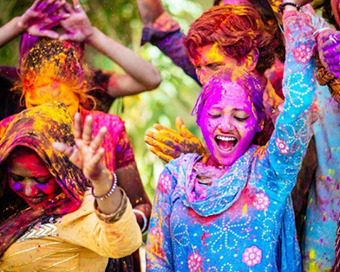Gallery
 PM Modi visit USA
PM Modi visit USA Only the mirror in my washroom and phone gallery see the crazy me : Sara Khan
Only the mirror in my washroom and phone gallery see the crazy me : Sara Khan Karnataka rain fury: Photos of flooded streets, uprooted trees
Karnataka rain fury: Photos of flooded streets, uprooted trees Cannes 2022: Deepika Padukone stuns at the French Riviera in Sabyasachi outfit
Cannes 2022: Deepika Padukone stuns at the French Riviera in Sabyasachi outfit Ranbir Kapoor And Alia Bhatt's Wedding Pics - Sealed With A Kiss
Ranbir Kapoor And Alia Bhatt's Wedding Pics - Sealed With A Kiss Oscars 2022: Every Academy Award Winner
Oscars 2022: Every Academy Award Winner Shane Warne (1969-2022): Australian cricket legend's life in pictures
Shane Warne (1969-2022): Australian cricket legend's life in pictures Photos: What Russia's invasion of Ukraine looks like on the ground
Photos: What Russia's invasion of Ukraine looks like on the ground Lata Mangeshkar (1929-2022): A pictorial tribute to the 'Nightingale of India'
Lata Mangeshkar (1929-2022): A pictorial tribute to the 'Nightingale of India' PM Modi unveils 216-feet tall Statue of Equality in Hyderabad (PHOTOS)
PM Modi unveils 216-feet tall Statue of Equality in Hyderabad (PHOTOS)The Badminton Association of India (BAI) has announced a 14-member-strong India squad for
- Men’s Sr Hockey Nationals to be played in division-based format from April 4
- Mensik denies Djokovic 100th title in Miami final
- KIPG: Son of a vegetable vendor, Bihar’s Jhandu Kumar eyes Worlds, 2028 Paralympics
- Hardik Singh credits hard work and team unity for receiving HI Midfielder of the Year award
- Djokovic, Alcaraz land in same half of Miami draw
Wellness benefits of celebrating Holi Last Updated : 25 Mar 2021 03:23:38 PM IST 
A festival celebrated joyously all over India Holi is a day of colours, where people of all ages and ethnicities have fun dousing each other in dyes and coloured water. Holi festival is based on one of the famous legends of killing evil demoness Holika. Another one of the famous legends is the one Lord Krishna complaining to mother Yashodha about Radha being fairer as compared to him. Mother Yashodha suggests that Krishna should colour Radha, in the colour of his choice. The mischievous Krishna is said to have coloured his beloved in a hue of colours thereafter. A tradition that is thereby we have been following.
Associated with the colour white, Holi symbolizes the end of one phase and the beginning of a new tomorrow. As Holi nears us, we celebrate the return of colours on the trees, in the sunsets, the arrival of spring, the end of winter. Holi stresses the need to get rid of the impassive winters, long nights and dry skin and lackluster hair. Interestingly, traditional Holi ritual and customs step in as the perfect body-rejuvenation therapy.Colours and the mindColours, as we all know, are vital for a healthy body. While immersed in the vibrant colours of Holi, our mind and body experience myriads of benefits. Bright colours like red tend to stimulate the heartbeat & breathing. Colours like Yellow and Blue don't just bring in a calming effect on our senses but also surround us with a sense of joy and happiness.Advantages of Holika DhahanHoli, like many other festivals, falls on the cusp of winters and spring. This season also exposes us to a number of bacteria and pollution in the air around us. The mutation period of winter and spring induces the growth of bacteria in the atmosphere as well as in the body Hence, the burning of Holika, the day before Holi, where many lights a bonfire that symbolizes the burning of evil, follows the tradition of walking around the fire deodorizing our environment and cleansing the body from the bacteria.Natural and organic coloursTraditionally the Holi colours were created with naturally helpful ingredients like hibiscus flowers, henna leaves, Kesar, sandalwood and more. These natural colours are not just good for your skin, hair and eyes but even cleanse and clear the dead skin. Ingredients such as these are used in Ayurveda for rejuvenating the body and giving it a healthy glow. Red colour is energizing and stimulate heart functions and breathing. Yellow has a soothing effect on organs especially the intestines and blue has a calming and tranquilizing effect on our body and senses.Cool, energizing drinksWake up from our chilling winter slumber, our body needs more than just a cold shower. Renowned Holi drinks like Thandai and Kaanji act as great coolants and are an excellent source of anti-oxidants. Thandai, comprising of delicious milk flavour, has the goodness of almonds, watermelon seeds, fennel seeds and rose petals. While Kaanji, a traditional North Indian drink is fermented and packed with rich nutrients and fibre.The festival of Holi also promotes good health in the southern regions of India. The morning after the burning of Holika, people put ash (Vibhuti) on their forehead. Along with that, they also mix Chandan (sandalwood paste) with the leaves and flowers from the Mango tree and consume it.IANS New Delhi For Latest Updates Please-
Join us on
Follow us on








172.31.16.186







